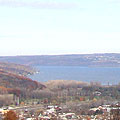- By -Staff
- News
 Print
Print  Following several months of discussion, deliberation and research, the Board of Directors of the Cayuga Lake Watershed Network has voted to approve a Position Statement on Hydraulic Fracturing (see full text below).
Following several months of discussion, deliberation and research, the Board of Directors of the Cayuga Lake Watershed Network has voted to approve a Position Statement on Hydraulic Fracturing (see full text below).The Cayuga Lake Watershed Network (CLWN) is a 14-year-old grassroots membership organization dedicated to protecting the waters of Cayuga Lake and of the 37 creeks that drain to this 38-mile long, 435-feet deep lake at the center of New York State’s majestic Finger Lakes, which drain to Lake Ontario. As pointed out in the position statement, “These local water bodies define our region, providing clean water that supports the life, economy, and lifestyles of our region. All of our residents depend on the lake, its creeks, and groundwater resources for clean drinking water, as do our vibrant agrarian livelihoods.”
CLWN’s mission is, 'to identify key threats to Cayuga Lake and its watershed, and advocate for solutions that support a healthy environment and vibrant communities.'
As a result of its Board’s deliberative process, the group has concluded that, “In hydraulic fracturing we have identified a key threat to the Cayuga Lake Watershed. A growing body of science indicates that shale gas extraction would contaminate our fresh waters, pollute our air, negatively impact sustainable livelihoods and our local economy, and aggravate climate change. Development of shale gas would also forestall the growth of the renewable energy sector that offers to bolster our economic vitality and curtail greenhouse gas emissions. We oppose the continuation of hydraulic fracturing and urge immediate emphasis on an energy policy that promotes conservation and renewable energy sources.”
Board member Mark Witmer, a Caroline resident, said, “If you’re not part of the solution, you’re part of the problem. With hydraulic fracturing it’s clear that there are some very big problems. I think our statement reflects our commitment to being part of the solution, one that will last.”
The group’s position statement delineates the clean water needs of the regional economy for “Wineries, vineyards, orchards, vegetable and grain farms, dairy farms, breweries, cheesemakers and creameries,” plus tourism, and summarizes potential negative impacts of hydraulic hydrofracturing and associated gas drilling activities to water resources, human and animal health, local and regional economies, and climate change. A 15-item list of up-to-date science-based references is included for concerned citizens who want to examine the issue further.
CLWN’s Steward (Executive Director) Hilary Lambert states that, “Not one aspect of hydraulic hydrofracturing is protective of the water quality of our creeks or lake. This statement points the way toward a clean-water focused, sustainable future for our regional economy and way of life.”
v8i19



